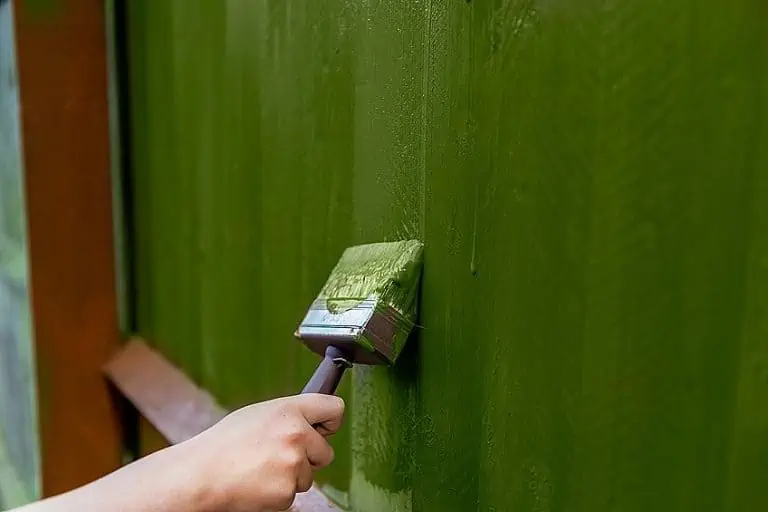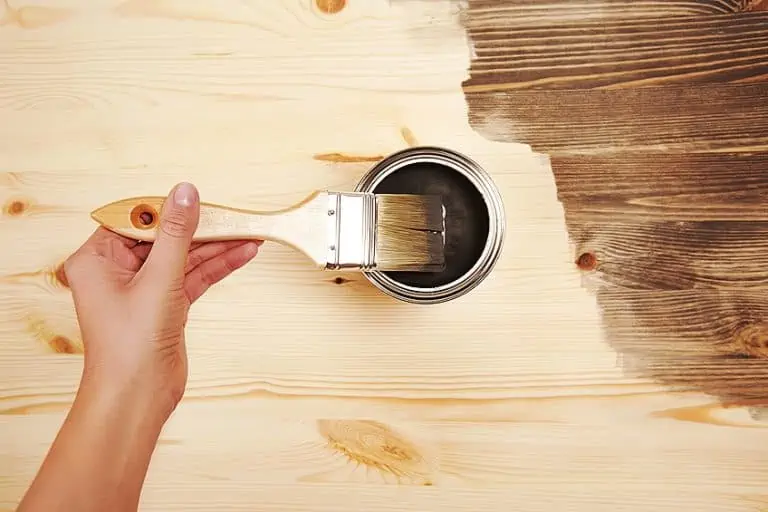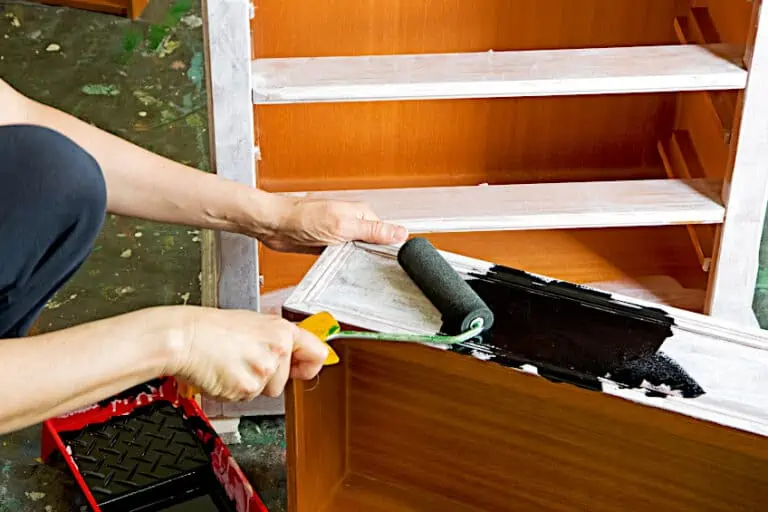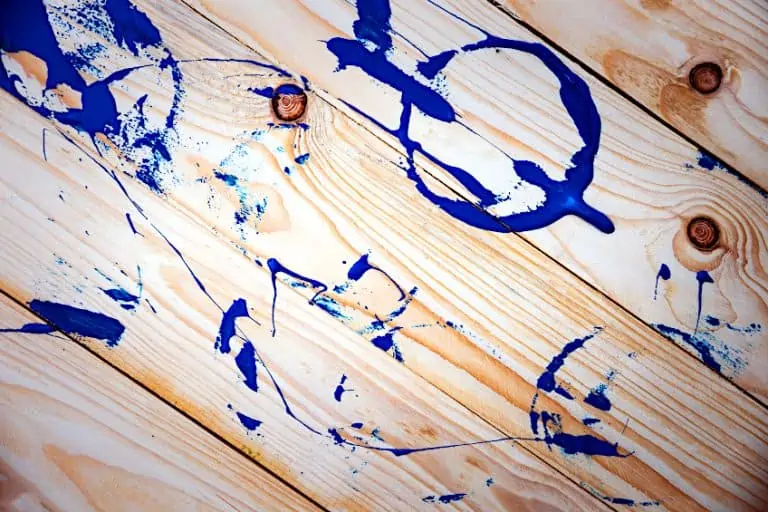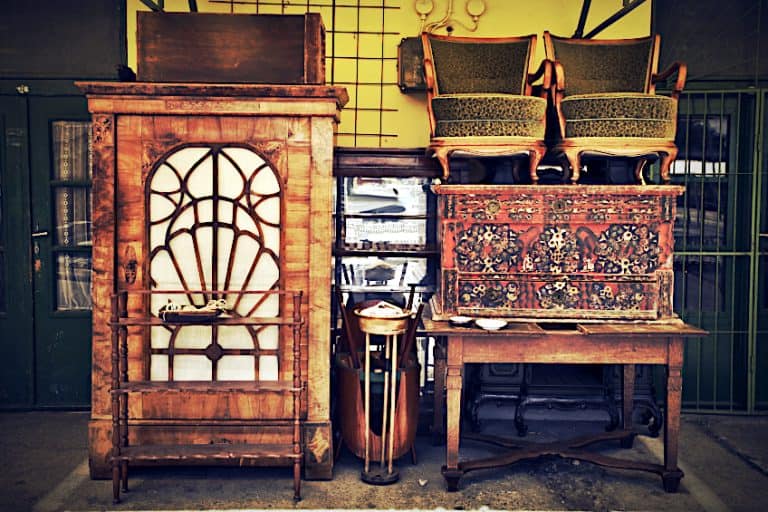Can You Paint Cedar? – How to Prepare Cedar for Painting
Cedar has developed a reputation over the years as being unpaintable. This is understandable considering that it is an extremely dense hardwood that tends to reject paint due to its tightly packed pores. Does this mean that cedar is genuinely unpaintable, though? Well, we decided to have a look into what cedar wood is, what its characteristics are, what makes it unique, and whether or not it is truly impossible to paint the surface of cedar board. If you’ve been thinking about staining cedar, this is definitely the guide you’re looking for!
Table of Contents
What Is Cedar Wood?
| Cedar Wood | Characteristics |
| Tensile Strength | 218 psi |
| Grain Pattern | Straight grained |
| Density | 21 pounds per cubic foot |
| Porosity | Non-porous |
| Workability | Easy to work with |
| Region of Origin | North West Pacific Coasts, United States |
| Applications | Decking, shingles, furnishings, cabins, cabinetry, utensils, tool handles, and crafting |
Cedar wood is one of the most popular hardwood species on the face of the planet. Cedar is native to North America and has been used in various decorative and structural applications both in the United States and other places all over the world. It is believed that cedar has been used to create tools, boats, and housing structures for nearly 8000 years, starting with Native American tribes.
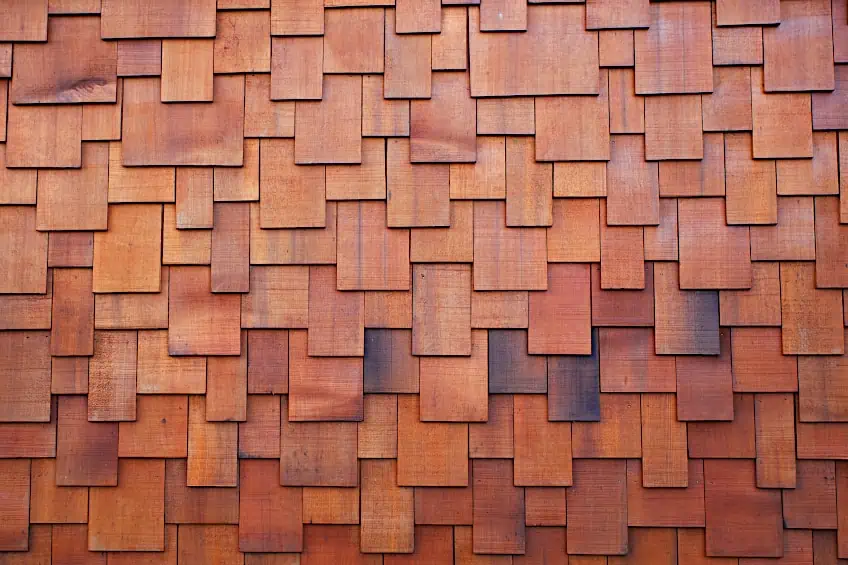
There are many characteristics that make cedar wood a good building and crafting material. For one, it is one of the most durable wood species among the American hardwood variety, sporting an impressive tensile strength and density. This means that structures and furnishings that are built with cedar are difficult to damage and are capable of withstanding the test of time.
Despite its dense wood grain, cedar wood is actually quite light, making it the ideal wood for a number of applications where a strong but light material is needed. Aside from its inner physical properties, cedar is absolutely beautiful to look at too! Cedar wood is uniform and straight-grained, making for eye-catching workpieces and structures.
In addition to its strength, durability, and aesthetics, cedar wood is also incredibly easy to work with compared to many other hardwood species. Whether you’re planning, cutting, sanding, or gluing this wood, you’d find it an absolute pleasure to work with, at least compared to other hardwood species in its class and tensile strength range. One of the most unique features of this wood species is its ability to not only insulate you from heat and cold but from sound too! That’s right cedar has sound-dampening abilities that make it the ideal material to create wood cabins out of, although, you might find this exercise quite costly considering how much demand there is for this wood species.
Can Cedar Be Painted?
Can you paint cedar wood? Wood species that are extremely dense or have an inherent low porosity tend to be difficult to paint. This is because it’s difficult for the paint to bond with the internal wood fibers of the board. It can be even worse if the wood has a high concentration of wood sap, which tends to hinder the adhesion process.
Can you paint cedar then? Yes! While cedar does have quite a dense wood grain there are ways you can work around it.
There are many people who believe that it is impossible to paint cedar, but it is possible given that the wood has been properly prepared and adequately primed to receive said paint. In fact, cedar is quite good at absorbing wood stains and wood treatment oils too.
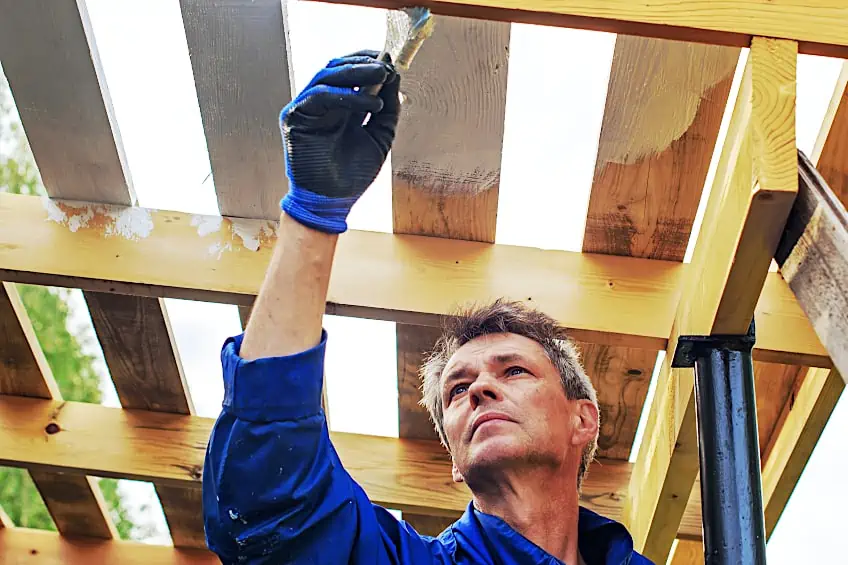
What makes cedar so challenging to stain is the fact that it is highly resinous. What does this mean? Simply, it means that it is chocked full of resin and tree sap that will eventually bleed through and stop paint from adhering to it. This in combination with its density means that you need to thoroughly prepare the surface of your cedar wood before it can be painted.
Choosing the Right Paint for Cedar Wood
Choosing the right paint for your cedar is also an important part of ensuring a stable and good-looking finish. What type of paint is best suited for cedar workpieces? Many crafters tend to agree that 100% pure acrylic latex paint or oil-based is the best way to go, due to the way the paint interacts with the wood fibers. That being said, we wouldn’t recommend trying another paint type.

How do you know you’ve chosen the right paint for your cedar workpiece though? Well, there are many brands and qualities of paint to choose from, so it’s best to look at reviews, ask for advice, and/or simply go with a brand that you have come to trust. At the end of the day though you’ll have to choose between oil-based paint and acrylic-latex paint. Here are the primary characteristics of each.
Oil-Based Paints
Oil-based paints are one of the oldest paint types on the face of the planet. It is believed that they have been around since the 7th century AD, and they’ve come quite a long way since their inception. Oil-based paints are highly durable, adhere well to various materials, and produce strikingly rich colors once they’ve dried. This made oil-based paint extremely popular in the old world, seeing various professional artists using this paint type to compose masterpieces of modern art that would forever change the world. What makes this paint so special then? Well, its base consists of drying oils, typically linseed oil, that has had pigment suspended in them.
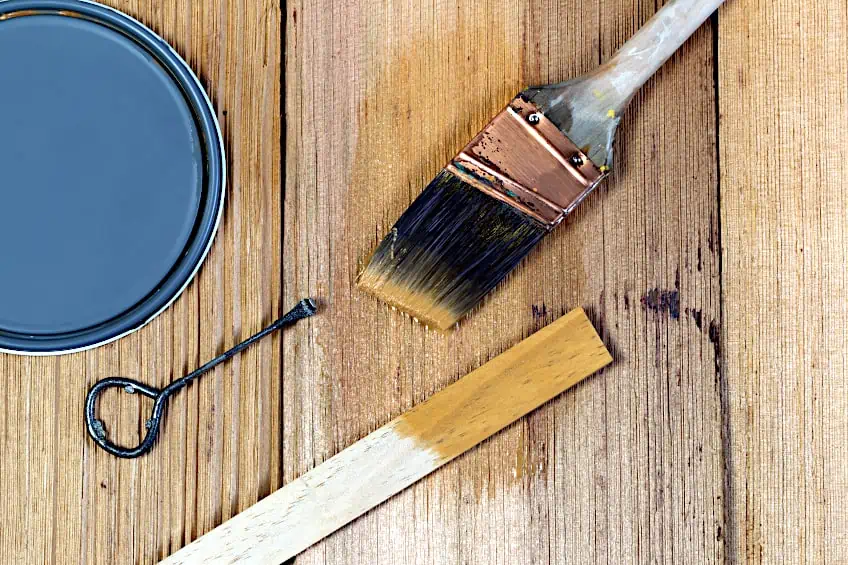
When the paint is applied to a surface and allowed to dry, the solvents present in the drying oil evaporate, allowing the pigment to stain the surface of your workpiece. Oil-based paints generally have an incredibly vibrant and lustrous finish to them, which is why many famous works of art are entirely composed of this incredible paint. Using oil-based paint does have its downsides though. While it might produce incredible color, it does not dry very quickly, which can be extremely frustrating if your project is time sensitive. Oil-based paints require an ideal temperature and humidity in order to dry correctly. Additionally, oil-based paints tend to be pretty expensive and contain loads of VOCs (volatile organic chemicals).
That being said, oil-based paints are also highly durable compared to their acrylic-latex counterparts. Why? Oil-based paints actually bind with wood fibers when they’re applied. This makes them a sort of combination between wood treatment oil and surface coating. This ensures both internal and external protection for your workpiece, which is ideal.
PROS
- Easy to use
- Readily available
- Protects workpiece internally and externally
- Ideal for outdoor workpieces
- Extremely durable
- Produces a rich color pallet
CONS
- Takes a long time to dry
- Cannot be applied indoors
- Challenging to remove
- Can be expensive
- Does not work on all wood types
Acrylic-Latex-Based Paint
It can be easy to get confused between acrylic paint and acrylic-latex-based paint. Acrylic paint is essentially pigment and solvent that have been suspended in an acrylic binder. This paint is highly durable and is used in a wide variety of applications in many industries all over the world, however, it’s not the best tool to use for painting cedar wood. Acrylic-latex-based paint is slightly different compared to acrylic paint. Acrylic-late is actually water-based paint and dye that has been suspended in an acrylic binder, a combination that has proven to be extremely effective in both adhesion and color transference. That being said, it is the ideal paint type for many crafters when attempting to paint cedar wood.
This paint type is known for a number of unique characteristics. Not only is it superior to many paints in terms of adhesion, but it is also washable, and far more flexible compared to pure latex or pure acrylic paints. Aside from being versatile, it is also highly durable and can be used for interior and exterior applications, making it highly sought after and sometimes expensive.
Acrylic-latex paint is also known for its ability to retain its color for far longer than both latex-based paint and oil-based paint. Acrylic-latex-based paints, unlike their oil-based counterparts, do not have many downsides to their use and are generally used as the first choice when painting cedar siding and other types of cedar surfaces. What makes this paint ideal for painting cedar siding? Well, aside from being robust, it’s the way that acrylic-latex paint interacts with the wood. Due to being water-based, it’s a lot easier for the paint to bind with wood fibers, and since it dries quickly there’s no time for the resin content of the wood to reject the paint. Here are some of the pros and cons associated with acrylic-latex paint.
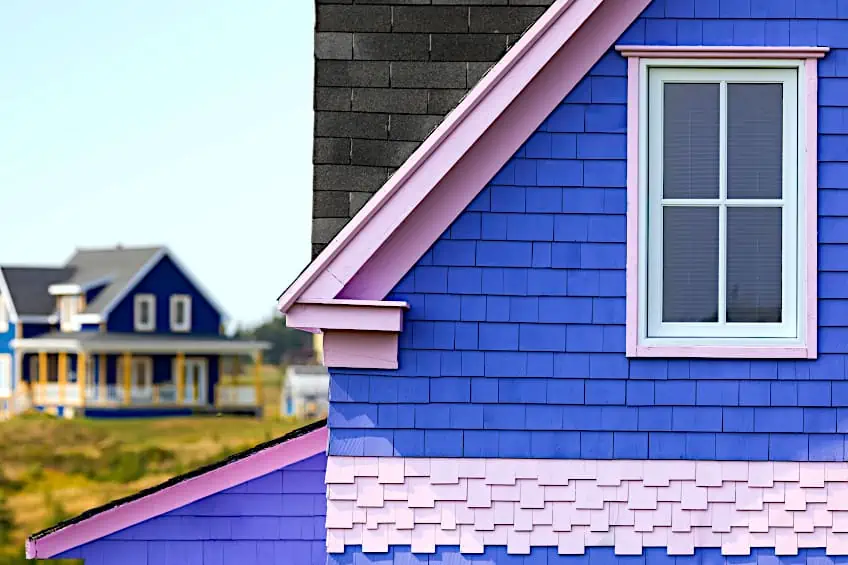
PROS
- Easy to use
- Highly durable
- Good color retention
- Dries quickly
- Contains few VOCs
- Sets into wood quickly
- Can be used indoors and outdoors
CONS
- Does not provide vibrant color
- Expensive
- Can be difficult to find in store
- Not ideal for all wood types
- Can be challenging to remove
How to Prepare Cedar Wood for Painting
As we mentioned previously, painting cedar can be a challenging thing to do especially if the surface is not prepared correctly. That being said, it’s important to understand how to properly prepare your cedar workpiece before your paint is applied.
Since one of the most common cedar workpieces to be painted is siding, here are a few steps you should follow when preparing your cedar siding for a future paint job.
Prepare Your Workspace
Before preparing the surface of your board you should ensure that your workpiece is prepared as well. The first thing that you should do is ensure that there is proper airflow in your immediate area. Remember that if you’re going to be using an oil-based paint, it contains VOCs that can be harmful when inhaled or when it comes into contact with your skin. That being said, in addition to laying down a tarp to protect your flooring and/or the surface of your workbench, you should ensure that you wear the appropriate personal protective gear at all times when working with paint and primer.
This means wearing a set of gloves graded for use with paint as well as a face mask to protect your nose and mouth.
You should additionally ensure that all of your tools are ready to be used. The best way to do this is to place all of your tools on the side of your dominant hand so that you know where they are at all times, saving you a lot of time and effort while you’re working. Finally, ensure that your tarp and any other coverings are secured with some painter’s tape before moving on to the next step in the process.

Clean Your Board
The first step in ensuring your workpiece is prepared for painting is to ensure that it has been thoroughly cleaned. Cleaning your workpiece ensures that the paint is able to adhere to the surface of your workpiece and that it will be able to bond with the wood’s fibers once it has been applied. That being said, how do you clean a cedar surface for painting? Well, the first thing to do would be to brush the surface clean of all surface dirt. This can be done with a clean cloth or you can use some good old-fashioned soap and water and use a scrubbing brush. Be sure to get rid of all the dirt and grime on the surface of the wood, working from one end to the other thoroughly before moving on to the next step.
Once you’re sure that the surface has been cleaned as much as possible using the brush and soap, it’s time to get out the pressure washer. Why should your pressure wash the surface of your cedar wood? Well, pressure washing removes dirt that has been deeply embedded in the surface of your wood. How does it do this?
Basically, pressure washing opens up the pores of the wood and forces the dirt outward. Not only does this clean the wood board, but it also ensures that the primer will adhere to the surface with greater ease. All you need to do is evenly wash the surface of the wood much in the same way you did with the scrubbing brush.
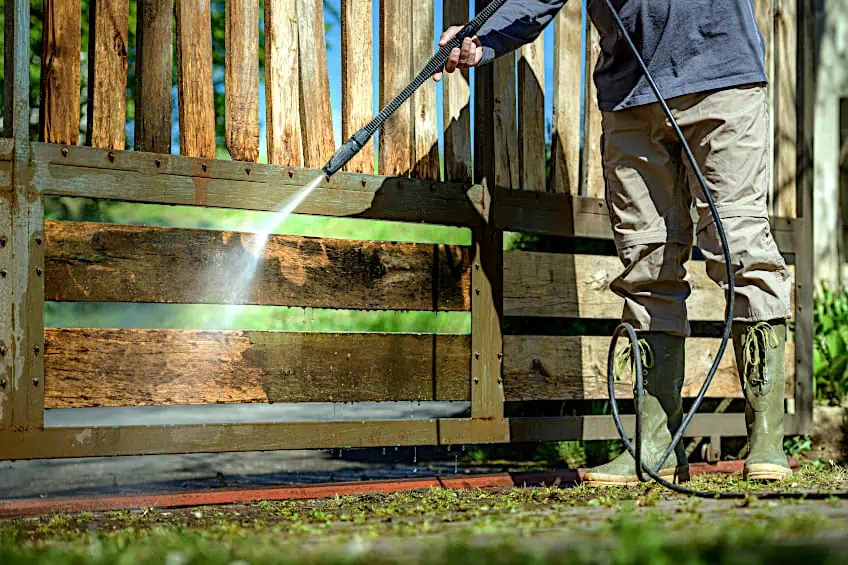
Once you’re done with pressure washing the surface, allow it to dry for two to four hours before attempting to alter the workpiece any further. Even after this time period has elapsed, ensure that the board has dried completely before attempting to move on to the next step in the process. Failing to do so can result in failed adhesion or an imperfect finish.
Sand Your Workpiece
One of the most important steps involved in the process of how to paint cedar siding is the sanding process during preparation. Why is sanding important? Sanding your surface allows you to expose fresh wood fibers beneath the initial surface layer that has become conditioned by the environment over time. How do you sand the surface of your cedar workpiece though? The best way for you to ensure that the surface of your wood is prepared correctly is to thoroughly sand it. How do you do this? We recommend starting off with medium-grit sandpaper (120-160 grit) and sand along the length of the board, following the direction of the board’s grain until the entire surface has been sanded.
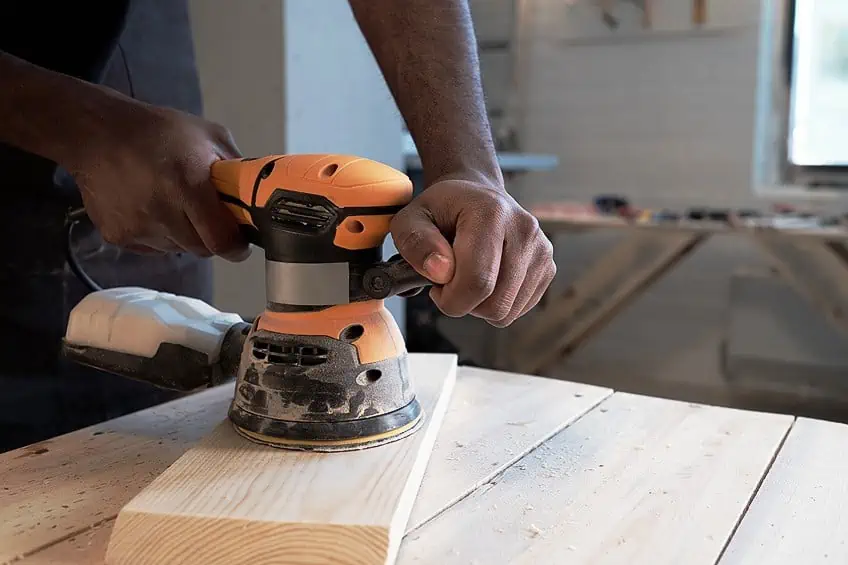
If you have a particularly large workpiece, you might want to sand it in sections, ensuring that each sanded section is blended into the other.
If your workpiece is circular and/or irregularly shaped, you could try working from the center of the board outward or vice versa. Regardless, the idea is to ensure that the surface is sanded as evenly as possible. Once you’re happy with the job you’ve done sanding the surface of your cedar board it’s important to ensure that it is clean before you prime it. The best way for you to go about this is to wipe off all the remaining wood particles either by using a clean cloth or by using some compressed air depending on your preference and/or what you have available to you.
Prime Your Workpiece
Priming your workpiece is the final step in the preparation process. If you don’t know what prime is, it’s essentially a substance that allows your paint to adhere to the surface with greater ease, while acting as a base coat that ensures your paint has an even tone once it’s been applied. There are many primers on the market, but you want the type designed for the paint you’ll be using.
If you’re going to be using an oil-based paint you should use a primer designed for it. If you’re using an acrylic-latex-based paint you should use a primer that has been designed for it. You should also consider whether you would like to apply your primer with a brush or if you’d prefer to use an aerosolized primer instead.
If you are applying your primer using a brush and roller the first thing you should do is give the container a good shake. Once that is done, pour some primer out into a painter’s tray, get some on your brush or roller, and begin applying it to the surface of your workpiece. Following the length of your cedar board, which is particularly large, apply the primer in sections, blending them with one another as you go along.
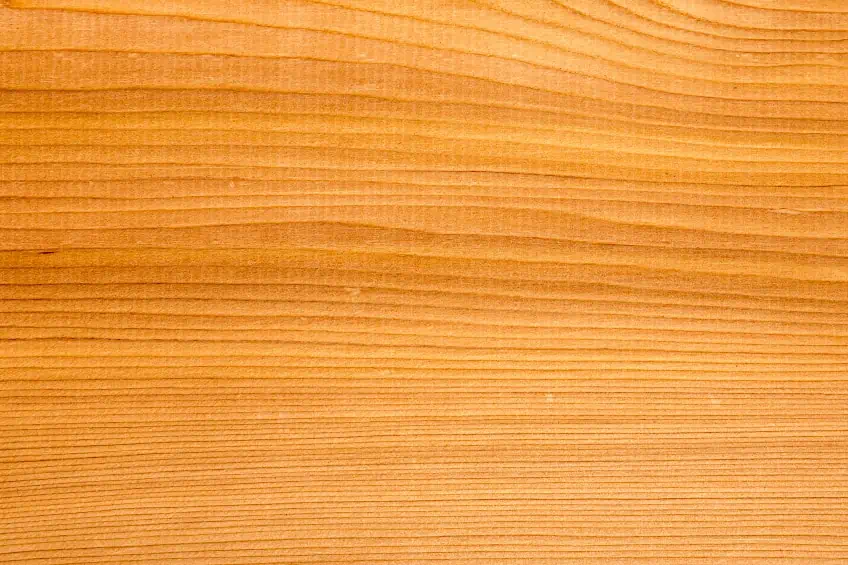
If you are using an aerosolized primer, start off by giving the spray can a good shake and start by spraying off the board. Next, move your wrist in one smooth, uninterrupted motion across the surface of your workpiece, until you are slightly off the other end of the board. Repeat this process until the entire surface has been primed. Once you’re happy, allow the primer to dry and cure for the manufacturer’s recommended time period before moving on to the next step in the process.
Paint Your Cedar Surface
Now that you know how to prepare cedar siding for painting, it’s time to get to the actual painting. There are two ways you can go about painting our cedar siding, you can either use the good old-fashioned method of a brush and roller, or you can use a paint sprayer.
Both have their respective pros and cons, but will ultimately get the job done.
Using a Brush and Roller
Painting your workpiece is not unlike priming it. If you are using a brush and roller, give the paint a good stir to ensure that the heavier particles at the bottom of the can are reintroduced into the mixture. Next, pour some out into a painter’s tray and get some on your brush. Paint along the length of your workpiece following the direction of your wood grain.
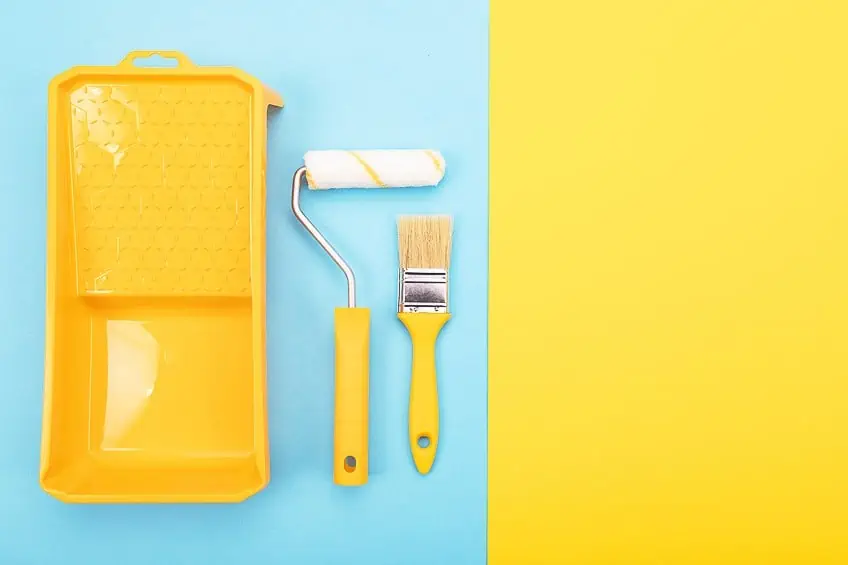
Again, the goal here is to ensure even, smooth coverage and to have a uniform surface. If your workpiece is large, section it off and blend each section in with the next. If your workpiece is irregularly shaped, try working from the center outward or vice versa. Repeat this process until your entire workpiece has been covered.
Using a Paint Sprayer/Aerosolized Spray Paint
Using a paint sprayer or aerosolized spray paint can make things a lot easier if you have a big workpiece or if you have multiple smaller workpieces to paint. To prepare, either give your paint can a good shake or pour the paint of your choice into the hopper of your paint sprayer. As you did with the primer, start by spraying slightly off the workpiece. Move your wrist in one smooth, uninterrupted motion across the surface of your workpiece, ensuring that you apply consistently even pressure to the spray trigger throughout. Stop once you’re slightly off the other end of the workpiece.
Usually, you want to ensure that you are around 12 inches away from your surface, but this can vary depending on your sprayer.
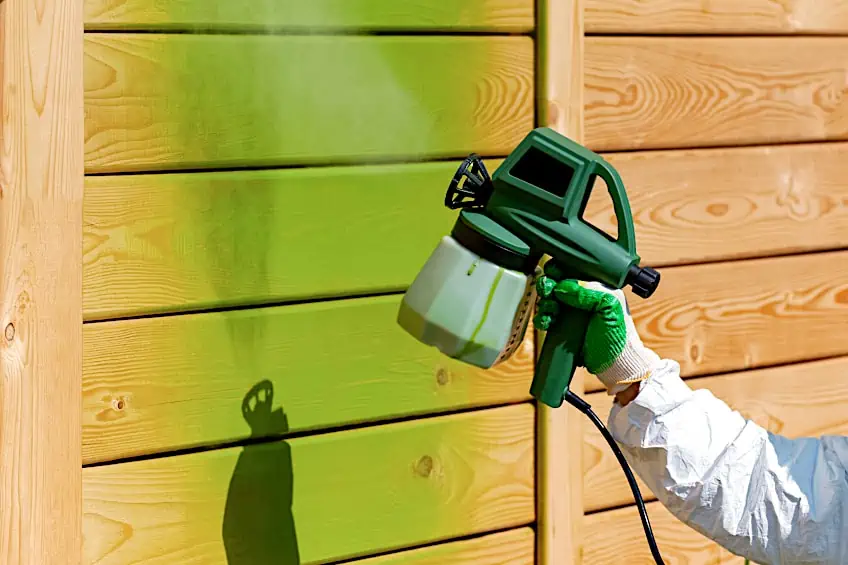
Repeat this process until the entire surface has been coated in paint. Allow each coat to dry for the manufacturer’s recommended time period before trying to apply another. Once you’ve applied your final coat you can choose to seal your workpiece using something like acrylic varnish or another type of hard-wearing sealer.
Now that you know what cedar wood is, what some of its characteristics are, how to prepare cedar siding for painting, and how to paint cedar siding, it’s time for you to get out there and put your newfound knowledge to the test. Remember to always ensure that your workspace is well-ventilated and that you are wearing the appropriate personal protective gear!
Frequently Asked Questions
Can Cedar Be Painted White?
Cedar can be difficult to paint due to its resinous nature. Can cedar be painted white, though? Yes, as long as a high-quality primer is used to ensure that the tannin is not allowed to bleed through your white paint coat, then you can use white to paint cedar wood.
Is Cedar a Good Wood?
Objectively speaking, cedar is a good wood. Not only is cedar wood very strong, but it can be painted, stained, cut, planed, and even bent. This makes cedar a popular wood species not only in the United States, but all over the world.
Does Cedar Wood Rot When Wet?
No, cedar is a non-porous wood, meaning that even though it has pores on the surface of its board, they are not big enough to allow moisture to seep into the fibers of the wood and cause it to rot. It is also highly resinous, allowing it to reject invasive substances and insects.

I have been into woodworking since 2005 and woodturning since 2011. Because of my love for wood and woodworking, I started woodhappen.com to teach other enthusiasts about how to finish and seal wood, the best woodworking tools, the different types of wood, and everything else related to woodworking! Read more about me here.


